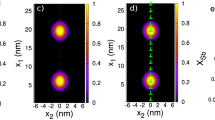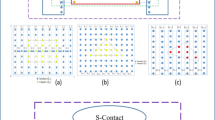Abstract
A physicochemical model is put forward for the dissolution (corrosion) of a metal with point lattice defects, i.e., vacancies and impurity atoms with corrosion stability radically different from that of the base metal. The model takes into account the substantial difference in the dissolution rates of the base metal atoms from positions with different numbers of neighboring atoms, which leads to the formation of characteristic nanofragments of the atomic surface relief. These fragments determine the dissolution rate. The point defects substantially affect the dissolution rate of the base metal exclusively due to their active involvement in the formation of the atomic relief. The equations describing this model allow the polarization curves of active dissolution of the base metal to be calculated as a function of the defect concentration.
Similar content being viewed by others
References
Alekseev, Yu.V., Alekseev, G.Yu., and Alekseev, I.Yu., Protection of Metals, 2007, vol. 43, no. 5, p. 436.
Alekseev, Yu.V., Alekseev, G.Yu., and Bityurin, V.A., Russ. J. Electrochem., 2010, vol. 46, no. 10, p. 1141.
Alekseev, Yu.V., Alekseev, G.Yu., and Bityurin, V.A., Protection of Metals, 2002, vol. 38, no. 6, p. 517.
Alekseev, G.Yu., Alekseev, Yu.V., and Bityurin, V.A., Protection of Metals, 2003, vol. 39, no. 6, p. 521.
Alekseev, Yu.V., Alekseev, G.Yu., and Bityurin, V.A., Protection of Metals, 2007, vol. 43, no. 3, p. 224.
Alekseev, Yu.V., Problemy Protivokorrozionnoi Zashchity, 2011, no. 1, p. 59.
Plaskeev, A.V., Protection of Metals, 2005, vol. 41, no. 2, p. 131.
Alekseev, Yu.V., Russ. J. Phys. Chem. A, 2008, vol. 82, no. 10, p. 1699.
Alekseev, G.Yu., Alekseev, Yu.V., and Bityurin, V.A., Protection of Metals, 2005, vol. 41, no. 3, p. 221.
Gibbs, J.W., Thermodynamische Studien, Leipzig, 1892.
Kossel, W., Nachr. Ges. Wiss. Gottingen. Math.-Physik K1, 1927, vol. 135, p. 74.
Stranskii, I.N. and Kaishev, R., Usp. Fiz. Nauk, 1939, vol. 21, no. 4, p. 408.
Volmer, M., Kinetika Obrazovaniya Novoi Fazy (Kinetics of New Phase Development), Moscow: Nauka, 1983.
Frenkel’, Ya.I., Zh. Eksp. Teor. Fiz., 1946, vol. 16, p. 39.
Landau, L.D., in Sbornik, posvyashchennyi semidesyatiletiyu akad. A.F. Ioffe (Collection of Papers Dedicated to the 70th Jubilee of Academician A.F. Ioffe), Moscow: AN SSSR, 1950, p. 44.
Glasstone, S., Laidler, K., and Eyring, H., The Theory of Rate Processes, New York: McGraw-Hill, 1941.
Damaskin, B.B., Petrii, O.A., and Tsirlina, G.A., Elektrokhimiya (Electrochemistry), Moscow: Khimiya, 2001.
Alekseev, Yu.V., Alekseev, G.Yu., Bityurin, V.A., and Plaskeev, A.V., Protection of Metals, 2006, vol. 42, no. 6, p. 526.
Alekseev, Yu.V., Protection of Metals, 2006, vol. 42, no. 4, p. 307.
Author information
Authors and Affiliations
Corresponding author
Additional information
Original Russian Text © Yu.V. Alekseev, G.Yu. Alekseev, V.A. Bityurin, 2012, published in Elektrokhimiya, 2012, Vol. 48, No. 1, pp. 48–63.
Rights and permissions
About this article
Cite this article
Alekseev, Y.V., Alekseev, G.Y. & Bityurin, V.A. Statistical atomic-topographic model of the active dissolution of metals with point lattice defects. The effect of point defects (vacancies and impurity atoms) on the metal dissolution rate. Russ J Electrochem 48, 42–56 (2012). https://doi.org/10.1134/S1023193512010028
Received:
Published:
Issue Date:
DOI: https://doi.org/10.1134/S1023193512010028




